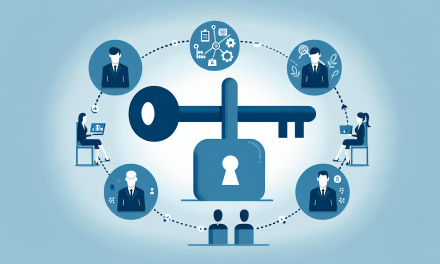Next, leverage technology to streamline communication and organize information. Various platforms, such as project management tools and collaboration software, can consolidate information in a user-friendly format. These tools not only enhance clarity but also improve accessibility. Utilizing automated systems to filter important information can also reduce the overwhelming influx of data.
Examples of Useful Tools
Some great examples include:
- Task management apps like Trello or Asana.
- Communication tools like Slack or Microsoft Teams.
- Centralized document storage using Google Workspace or Dropbox.
- Time management applications such as RescueTime.
Enhancing Personal Productivity
Another effective method to minimize information overload is to establish personal productivity habits. Techniques such as the Pomodoro Technique—where you split work into intervals, traditionally lasting 25 minutes, followed by a short break—help to maintain focus while preventing burnout. On top of that, implementing time-blocking strategies can protect against distractions by allocating specific time slots for each task.
Developing Focused Work Habits
Consider these additional tips:
- Set specific goals at the beginning of the day.
- Prioritize tasks using the Eisenhower Matrix.
- Limit time spent on email to specific intervals.
- Learn to say no when new tasks arise, especially if they conflict with your current priorities.
FAQs
1. What are common signs of information overload?
Common signs include difficulty focusing, increased stress, constant distractions, and a feeling of being overwhelmed by tasks or information.
2. How can employees improve their skills in managing information?
Employees can improve their skills by attending workshops or seminars on time management and productivity, as well as developing a personal system or routine for handling information.
3. Are there resources available to learn more about handling information overload?
Yes, you can explore comprehensive guides and articles. For instance, check out Mastering Information Overload Strategies in the Workplace for deeper insights.
4. How does effective communication help in reducing information overload?
Effective communication clarifies expectations, prioritizes tasks, and ensures everyone is on the same page, ultimately reducing the flow of unnecessary information.
Conclusion
In conclusion, information overload is a significant challenge in the workplace. However, implementing targeted strategies can alleviate its impacts. By fostering a culture of communication, employing effective technology tools, and enhancing personal productivity, employees can create a more manageable work environment. Stay aware of your habits and make necessary adjustments, and always remember to encourage your coworkers to find balance as well.
For further insights and strategies, you might also find these topics valuable:
- Mastering Performance Management: Unlocking Team Potential and Driving Success
- Cultivating Trust: The Initial Key to Fostering Strong Relationships
- Strategic Planning: Setting Effective Business Goals and Deliverables
- Enhancing Your Hiring Strategy with an Internal Talent Marketplace
First, it is essential to foster an open culture of communication. Encourage your employees to voice concerns and share insights about how they manage their workloads. Regular team check-ins can minimize misunderstandings while helping clarify priorities. Moreover, establishing clear communication protocols aids in direction and focus amidst the noise.
“Clarity fosters confidence; confidence inspires creativity.”
Employing Technology Tools
Next, leverage technology to streamline communication and organize information. Various platforms, such as project management tools and collaboration software, can consolidate information in a user-friendly format. These tools not only enhance clarity but also improve accessibility. Utilizing automated systems to filter important information can also reduce the overwhelming influx of data.
Examples of Useful Tools
Some great examples include:
- Task management apps like Trello or Asana.
- Communication tools like Slack or Microsoft Teams.
- Centralized document storage using Google Workspace or Dropbox.
- Time management applications such as RescueTime.
Enhancing Personal Productivity
Another effective method to minimize information overload is to establish personal productivity habits. Techniques such as the Pomodoro Technique—where you split work into intervals, traditionally lasting 25 minutes, followed by a short break—help to maintain focus while preventing burnout. On top of that, implementing time-blocking strategies can protect against distractions by allocating specific time slots for each task.
Developing Focused Work Habits
Consider these additional tips:
- Set specific goals at the beginning of the day.
- Prioritize tasks using the Eisenhower Matrix.
- Limit time spent on email to specific intervals.
- Learn to say no when new tasks arise, especially if they conflict with your current priorities.
FAQs
1. What are common signs of information overload?
Common signs include difficulty focusing, increased stress, constant distractions, and a feeling of being overwhelmed by tasks or information.
2. How can employees improve their skills in managing information?
Employees can improve their skills by attending workshops or seminars on time management and productivity, as well as developing a personal system or routine for handling information.
3. Are there resources available to learn more about handling information overload?
Yes, you can explore comprehensive guides and articles. For instance, check out Mastering Information Overload Strategies in the Workplace for deeper insights.
4. How does effective communication help in reducing information overload?
Effective communication clarifies expectations, prioritizes tasks, and ensures everyone is on the same page, ultimately reducing the flow of unnecessary information.
Conclusion
In conclusion, information overload is a significant challenge in the workplace. However, implementing targeted strategies can alleviate its impacts. By fostering a culture of communication, employing effective technology tools, and enhancing personal productivity, employees can create a more manageable work environment. Stay aware of your habits and make necessary adjustments, and always remember to encourage your coworkers to find balance as well.
For further insights and strategies, you might also find these topics valuable:
- Mastering Performance Management: Unlocking Team Potential and Driving Success
- Cultivating Trust: The Initial Key to Fostering Strong Relationships
- Strategic Planning: Setting Effective Business Goals and Deliverables
- Enhancing Your Hiring Strategy with an Internal Talent Marketplace
Here are several practical and friendly strategies that can be easily integrated into any workplace to manage information overload more effectively:
Creating a Culture of Communication
First, it is essential to foster an open culture of communication. Encourage your employees to voice concerns and share insights about how they manage their workloads. Regular team check-ins can minimize misunderstandings while helping clarify priorities. Moreover, establishing clear communication protocols aids in direction and focus amidst the noise.
“Clarity fosters confidence; confidence inspires creativity.”
Employing Technology Tools
Next, leverage technology to streamline communication and organize information. Various platforms, such as project management tools and collaboration software, can consolidate information in a user-friendly format. These tools not only enhance clarity but also improve accessibility. Utilizing automated systems to filter important information can also reduce the overwhelming influx of data.
Examples of Useful Tools
Some great examples include:
- Task management apps like Trello or Asana.
- Communication tools like Slack or Microsoft Teams.
- Centralized document storage using Google Workspace or Dropbox.
- Time management applications such as RescueTime.
Enhancing Personal Productivity
Another effective method to minimize information overload is to establish personal productivity habits. Techniques such as the Pomodoro Technique—where you split work into intervals, traditionally lasting 25 minutes, followed by a short break—help to maintain focus while preventing burnout. On top of that, implementing time-blocking strategies can protect against distractions by allocating specific time slots for each task.
Developing Focused Work Habits
Consider these additional tips:
- Set specific goals at the beginning of the day.
- Prioritize tasks using the Eisenhower Matrix.
- Limit time spent on email to specific intervals.
- Learn to say no when new tasks arise, especially if they conflict with your current priorities.
FAQs
1. What are common signs of information overload?
Common signs include difficulty focusing, increased stress, constant distractions, and a feeling of being overwhelmed by tasks or information.
2. How can employees improve their skills in managing information?
Employees can improve their skills by attending workshops or seminars on time management and productivity, as well as developing a personal system or routine for handling information.
3. Are there resources available to learn more about handling information overload?
Yes, you can explore comprehensive guides and articles. For instance, check out Mastering Information Overload Strategies in the Workplace for deeper insights.
4. How does effective communication help in reducing information overload?
Effective communication clarifies expectations, prioritizes tasks, and ensures everyone is on the same page, ultimately reducing the flow of unnecessary information.
Conclusion
In conclusion, information overload is a significant challenge in the workplace. However, implementing targeted strategies can alleviate its impacts. By fostering a culture of communication, employing effective technology tools, and enhancing personal productivity, employees can create a more manageable work environment. Stay aware of your habits and make necessary adjustments, and always remember to encourage your coworkers to find balance as well.
For further insights and strategies, you might also find these topics valuable:
- Mastering Performance Management: Unlocking Team Potential and Driving Success
- Cultivating Trust: The Initial Key to Fostering Strong Relationships
- Strategic Planning: Setting Effective Business Goals and Deliverables
- Enhancing Your Hiring Strategy with an Internal Talent Marketplace
Table of Contents
- What is Information Overload?
- The Impact of Information Overload
- Strategies to Handle Information Overload
- Creating a Culture of Communication
- Employing Technology Tools
- Enhancing Personal Productivity
- FAQs
- Conclusion
What is Information Overload?
In our fast-paced digital world, information overload has become a common challenge in the workplace. Quite simply, information overload occurs when the volume of input exceeds an individual’s capacity to process it. This challenge can lead to stress, decreased productivity, and poor decision-making.
To illustrate, think about the last time you felt overwhelmed by emails, reports, messages, and data analysis. Many professionals struggle daily to manage large amounts of information, which, unfortunately, can lead to burnout if not addressed. Understanding information overload is the first step towards developing effective strategies to combat it.
The Impact of Information Overload
The effects of information overload can be quite severe and multifaceted. A few common consequences include:
- Increased stress levels among employees.
- Reduced productivity, as individuals struggle to focus.
- Poor decision-making due to conflict or confusion around critical data.
- Higher employee turnover as a result of burnout.
To combat these challenges, organizations must implement effective strategies. Fortunately, numerous methods can help teams navigate the complexities of vast information networks.
Strategies to Handle Information Overload
Here are several practical and friendly strategies that can be easily integrated into any workplace to manage information overload more effectively:
Creating a Culture of Communication
First, it is essential to foster an open culture of communication. Encourage your employees to voice concerns and share insights about how they manage their workloads. Regular team check-ins can minimize misunderstandings while helping clarify priorities. Moreover, establishing clear communication protocols aids in direction and focus amidst the noise.
“Clarity fosters confidence; confidence inspires creativity.”
Employing Technology Tools
Next, leverage technology to streamline communication and organize information. Various platforms, such as project management tools and collaboration software, can consolidate information in a user-friendly format. These tools not only enhance clarity but also improve accessibility. Utilizing automated systems to filter important information can also reduce the overwhelming influx of data.
Examples of Useful Tools
Some great examples include:
- Task management apps like Trello or Asana.
- Communication tools like Slack or Microsoft Teams.
- Centralized document storage using Google Workspace or Dropbox.
- Time management applications such as RescueTime.
Enhancing Personal Productivity
Another effective method to minimize information overload is to establish personal productivity habits. Techniques such as the Pomodoro Technique—where you split work into intervals, traditionally lasting 25 minutes, followed by a short break—help to maintain focus while preventing burnout. On top of that, implementing time-blocking strategies can protect against distractions by allocating specific time slots for each task.
Developing Focused Work Habits
Consider these additional tips:
- Set specific goals at the beginning of the day.
- Prioritize tasks using the Eisenhower Matrix.
- Limit time spent on email to specific intervals.
- Learn to say no when new tasks arise, especially if they conflict with your current priorities.
FAQs
1. What are common signs of information overload?
Common signs include difficulty focusing, increased stress, constant distractions, and a feeling of being overwhelmed by tasks or information.
2. How can employees improve their skills in managing information?
Employees can improve their skills by attending workshops or seminars on time management and productivity, as well as developing a personal system or routine for handling information.
3. Are there resources available to learn more about handling information overload?
Yes, you can explore comprehensive guides and articles. For instance, check out Mastering Information Overload Strategies in the Workplace for deeper insights.
4. How does effective communication help in reducing information overload?
Effective communication clarifies expectations, prioritizes tasks, and ensures everyone is on the same page, ultimately reducing the flow of unnecessary information.
Conclusion
In conclusion, information overload is a significant challenge in the workplace. However, implementing targeted strategies can alleviate its impacts. By fostering a culture of communication, employing effective technology tools, and enhancing personal productivity, employees can create a more manageable work environment. Stay aware of your habits and make necessary adjustments, and always remember to encourage your coworkers to find balance as well.
For further insights and strategies, you might also find these topics valuable:





